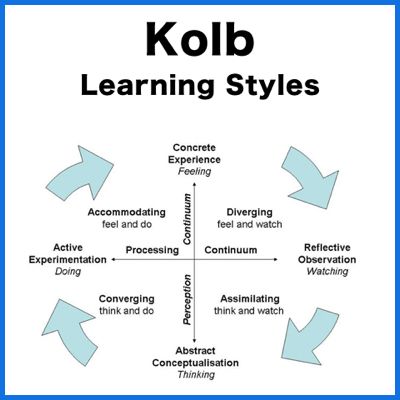Kolb Learning Styles: This article explains in a practical way David Kolb ‘s Kolb Learning Styles . After reading you will understand the basics of this powerful management tool .

What are Kolb’s learning styles?
The American psychologist David Kolb , together with Roger Fry, developed a model for an effective learning process in the 1970s. This management model, the Experiential Learning Model (ELM), is cyclical and is also known in science as Kolb’s four learning styles.
Through Kolb’s four learning styles, which is also a learning circle, it becomes clear that there is not just one way of learning, but that there are several methods and that each individual has his own preferred learning style.
Diversity
David Kolb discovered that people tend to develop mainly the learning phase in which they are strong. According to him, it is good to also pay attention to ways of learning in which one is less good.
Such diversity allows the learning cycle to be completed in a more complete and balanced way, with each phase receiving equal attention.
A group has this diversity by nature, so that the group members complement each other automatically. Thus David Kolb came to understand Kolb’s four learning styles.
Dimensions
David Kolb distinguishes in his four learning styles model two dimensions with the opposites “Concrete versus Abstract” and “Active versus Reflective”.
In practice, it appears that adults (unlike children) depending on experience and stage of life, first have to unlearn something before they can learn something new. Sometimes (undesirable) experiences have to be processed before they are open to new insights.
What are Kolb’s four learning styles?
Within the dimensions, Kolb’s four learning styles are based on a theoretical model of four key steps. David Kolb distinguishes the behaviors and the corresponding learning styles:
Kolb .’s Learning Styles

Kolb Learning Styles: This article explains in a practical way David Kolb ‘s Kolb Learning Styles . After reading you will understand the basics of this powerful management tool .
What are Kolb’s learning styles?
The American psychologist David Kolb , together with Roger Fry, developed a model for an effective learning process in the 1970s. This management model, the Experiential Learning Model (ELM), is cyclical and is also known in science as Kolb’s four learning styles.
Through Kolb’s four learning styles, which is also a learning circle, it becomes clear that there is not just one way of learning, but that there are several methods and that each individual has his own preferred learning style.
Diversity
David Kolb discovered that people tend to develop mainly the learning phase in which they are strong. According to him, it is good to also pay attention to ways of learning in which one is less good.
Such diversity allows the learning cycle to be completed in a more complete and balanced way, with each phase receiving equal attention.
A group has this diversity by nature, so that the group members complement each other automatically. Thus David Kolb came to understand Kolb’s four learning styles.
Dimensions
David Kolb distinguishes in his four learning styles model two dimensions with the opposites “Concrete versus Abstract” and “Active versus Reflective”.
In practice, it appears that adults (unlike children) depending on experience and stage of life, first have to unlearn something before they can learn something new. Sometimes (undesirable) experiences have to be processed before they are open to new insights.
What are Kolb’s four learning styles?
Within the dimensions, Kolb’s four learning styles are based on a theoretical model of four key steps. David Kolb distinguishes the behaviors and the corresponding learning styles:
Doer
This learning style shows a combination of active experimentation and concrete experience.
Doers prefer situations where they can get started as quickly as possible and learn best when there is room for direct experience by doing things.
Doers are open to new learning opportunities, are good at solving problems and find it a challenge to start on an unknown job.
Viewer
This learning style has a preference for concrete experience and reflective observation. Spectators like to think things through first and are champions of lateral problem solving.
They like to approach and look at a problem from all sides and see new entrances and solutions all the time. Spectators don’t want to be rushed and want to have time before making a decision.
Thinker
This learning style combines reflective observation with abstract conceptualization. Thinkers like to convert their observations into hypotheses and theories. They can reason well and like to work independently.
They learn best from structured situations with clear objectives, theories and models. They would like to have the opportunity to ask questions and discuss.
Decision maker
This learning style favors abstract conceptualization and active experimentation. Decision makers like to try theories in practice.
They often take initiative, are problem-solving and make decisions. They learn best from clearly and concisely formulated rules and principles, which they can apply right away. They are practitioners who don’t like wasting time.
Kolb’s learning styles are cyclical
Kolb’s learning styles is a cyclical process, in which all four stages of learning must be completed. This does not have to be done from the same starting point, but preferably in the same order.
Despite preference for a certain phase, according to David Kolb, the learning process becomes easier by going through all four learning phases.
Coherence
Until recently, in many study programs the emphasis was mainly on the assimilating learning style; reflection and theory building. They learned how certain things are related and how they can be seen in a theoretical framework.
Less attention was often paid to the accommodative learning style (experimentation and experience). By doing something, one gains experience (doer). Then one looks back at what exactly happened (the viewer).
After that, connections are made between these reflections and observations and a certain theory (thinker) is formed. Then people think about how something can be (even) better and will try it out in practice (decision maker). All-round learners master all four learning styles.
Develop yourself with Kolb’s learning styles
Personal development according to your own learning style
Many companies also suffer from the ‘one-size-fits-all syndrome’ in which copying behavior predominates and one employee can hardly be distinguished from another.
The result is clear: a lack of dynamism within the company. Every person is unique and goes through their own personal development.
That is why not only schools, but also organizations should focus much more on a personal learning style that ensures that every individual gets the best out of himself.
Learn in your own style
Get a group of people together and have them learn the same subject or skill. You will notice that everyone does this in their own way. Learning cannot be captured in one style.
Learning psychologist and educator David Kolb made a distinction between different learning styles and personalities.
David Kolb was based on doers, thinkers, dreamers and decision makers. They all go through different phases during the learning circle: concrete experience, observation and reflection, analysis and abstract thinking and active experimentation.
Personal development
Depending on the type of personality, someone steps into the learning circle.
- Doers like to tackle. Give them some concrete instructions and they will get to work right away. Active experimentation is their credo. You can solve problems by trying things out.
- Thinkers first choose to collect information. They link new knowledge to what they already know. Thinkers only get to work when they understand what they are doing.
- Dreamers don’t like quick decisions. They take their time and like to look at things from different angles. As a result, they often see different solutions that are all worth considering.
- Decision-makers take a pragmatic approach. They like to make a step-by-step plan and then try things out. They are more practical and not so interested in theory.
Taking advantage of Kolb’s learning styles
It is a lot easier for trainers when they have an idea whether the trainee is a doer, thinker, dreamer or decision maker. This allows them to develop person-oriented learning material.
You have to convince the decision maker of its practical usefulness. The thinker benefits most from an intellectual challenge. You do the doer a favor by stimulating him with a practical assignment.
The dreamer gets excited when confronted with different visions to solve a problem.
When employees can learn in a style that suits their own personality, they will be more motivated and achieve better results. Learning something new does not happen in a forced way, but, as it were, automatically.

Also read:
25 questions to get to know yourself better…
